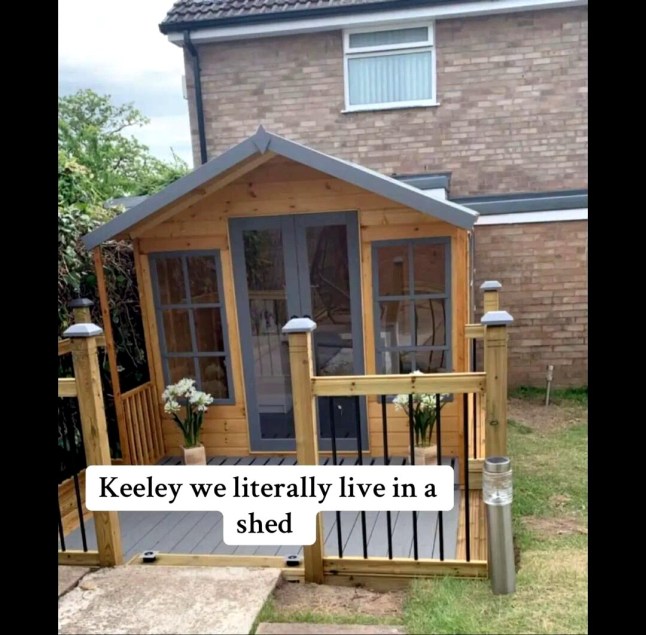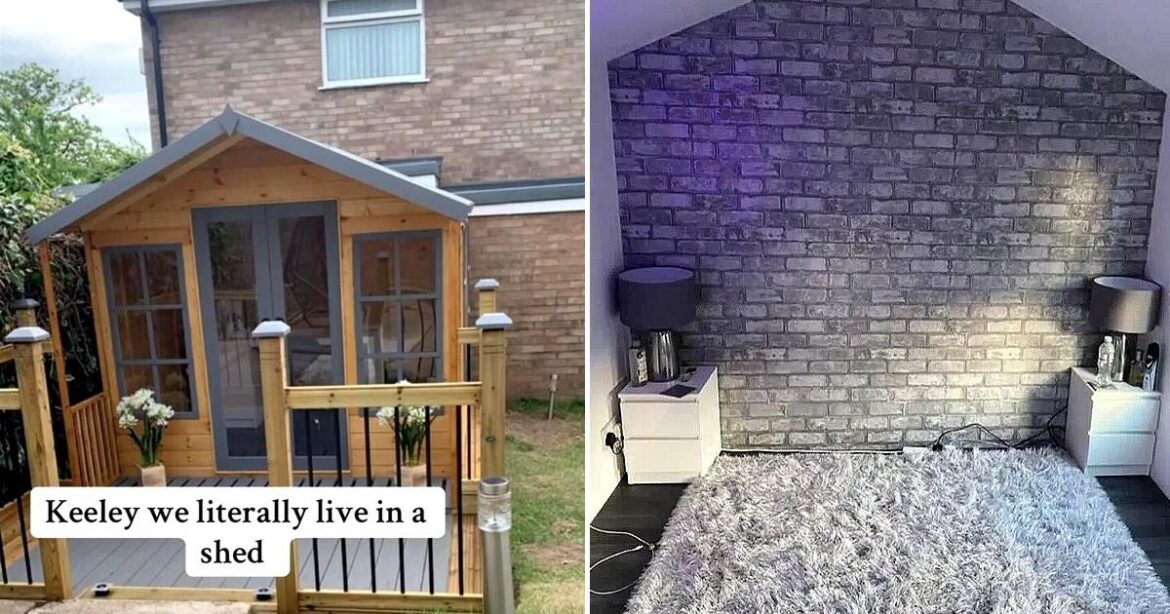
The family have since bought their own home (Picture: keeleywalxx)
A mother of two recently attracted widespread attention on TikTok after sharing her experience of living in a garden shed at the bottom of her parents’ garden.
Keeley’s candid story garnered over one million views and 40,000 likes on the platform, revealing an insight into an unconventional solution adopted by some young families facing the country’s housing crisis.
Keeley and her partner converted a modest garden shed into a fully functional living space, with a double bed, chest of drawers, and a television, all for approximately £2,000.
The couple chose the living arrangement as a strategy to save money and eventually purchase their own home, but Keeley revealed that while living there, they decided they wanted to have a baby.
Although the compact space was far from ideal for raising a family, the shed was intended only as a temporary residence, and Keeley revealed in the comments that her sister swapped houses with her during her pregnancy to offer a safer and more suitable environment.
The family has since moved into their own home, having used the shed as a stepping stone to accumulate savings for a mortgage.
Keeley’s story resonated widely, with many online viewers expressing sympathy, sharing similar experiences, or commending their ingenuity in converting the minimal outdoor space into a home.

Keeley said the shed cost around £2,000 to install (Picture: keeleywalxx)

She swapped homes with her sister during her pregnancy (Picture: keeleywalxx)
One user shared: ‘Me and my now husband lived in a shed in mum’s garden too!! Enabled us to save up for our house though’.
Another said: ‘We had our first baby living in a caravan in my parents garden during lockdown.’
Replying to one commenter who asked how much the shed cost, Keeley revealed: ‘It was £1500 from Argos then for inside for plastering/electrics and flooring was probs around £300-£500′.
Others were concerned about the temperatures in the shed during winter, but Keeley revealed they had an oil-filled radiator to keep them warm.
And some wondered whether the shed was legal and if it required planning permission.

Keeley revealed she stayed warm with an oil-filled radiator (Picture: keeleywalxx)
Legal and regulatory considerations of sheds and outbuildings
While converting sheds or garden outbuildings into living spaces is increasingly common across the UK, it can entail legal and regulatory complexities.
Although garden sheds may be built under ‘permitted development rights’ without formal planning permission, transforming them into living quarters often changes their legal classification.
This typically requires adherence to planning permission protocols and building regulations to ensure safety and habitability.

Sheds intended to be permanent dwellings may require planning permission (Picture: keeleywalxx)
Key regulatory requirements can include:
Compliance with building codes covering structural integrity and fire safety.
Meeting insulation and ventilation standards to ensure adequate heating and air quality.
Proper electrical installation to current safety standards.
Provision of water and drainage facilities if the shed includes kitchens or bathrooms.
Additionally, planning permission may be necessary if the garden shed is situated on sensitive land such as conservation zones or near listed buildings.
Recently, local councils in the UK have intensified scrutiny over outbuildings converted into habitable spaces, enforcing a so-called ‘garden shed tax’.
According to government guidance, a property is considered a separate dwelling if it has its own kitchen, bathroom, and an independent entrance, and therefore may be liable for council tax as a separate household.
Homeowners should consult local authorities and professionals before undertaking such conversions to avoid enforcement actions or complications during future property transactions.
And as housing affordability continues to pose challenges, such unconventional solutions may become increasingly prevalent, underscoring the need for clear guidance and support from planning authorities and policymakers.
Do you have a story to share?
Get in touch by emailing MetroLifestyleTeam@Metro.co.uk.
Arrow
MORE: Inside the $2,590,000 abandoned New York mansion built for Wall Street titan
Arrow
MORE: One in five first time buyers in the UK’s ‘broken’ property market are over 40
Arrow
MORE: Truman Brewery development could ‘rip the heart out of Brick Lane’
Comment now
Comments
Add Metro as a Preferred Source on Google
Add as preferred source
The Key
Sign up for must-read property stories, DIY hacks and tips for buying a home.


Comments are closed.